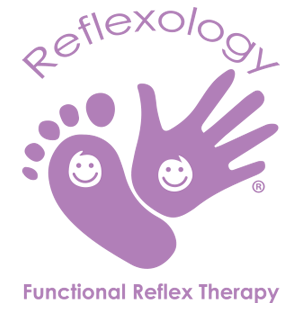Making your communication meaningful
My intention for delivering reflexology using the Functional Reflex Therapy framework, in the context of the special school environment, is to support the emotional wellbeing of pupils and to help them be in a better frame of mind to cope better with ongoing activities.
I support children and young adults who may have high levels of anxiety, challenges coping with daily activities, communication issues and some experiencing difficulties to access the world around them; often things that we take for granted.
Relaxation reflexology delivered using the unique FRT framework provides flow, rhythm and repetition and gives the receiver time to process the communication of my touch.
Many of the young people I support are not able to use speech and may have very limited verbal skills. They may have sensory processing difficulties which can often lead to frustration and which may lead them to them experiencing high levels of anxiety, tension and distress. As a result, this may be shown with behaviours that are quite challenging.
Like all therapists, I try to best meet the individual needs of my clients and in school I need to give a little more consideration, not only to my preparation, but to how I prepare the receiver. This will help them to understand what will be happening before, during and after the session. It is so easy to feel I am sharing plenty of information, but I need to ask myself how effective is the information I share and how meaningful is it?
Communication is not just the giving of information, it is a two-way process. It is about the giving of information and the understanding of it by the receiver. I’m sure you would all agree, it is very important for us to think about the purpose of our communication, how much we say, what we say and to carefully think about the way in which we say it.
I’m not going to provide you with the answers. I’m still learning about them myself, but I thought if I shared the questions, I ask of myself, and throw a few words your way, it might be helpful to you, and (if you need to) you may consider ways you can adapt the way you deliver information and how much information you deliver within your practice. Being more aware may help you to feel more confident and allow your reflexology therapy to be more accessible to all and to better meet the individual needs of your clients with communication issues.
Questioning our methods of practice is a ‘strength’ of our profession and a very important one. Working alongside evaluation and reflection, introducing new ideas if appropriate and reassuring ourselves we are always striving to do the best we can.
[activ_news_gallery id=”2″]
Under the umbrella of ‘meaningful communication’, you could consider the following questions for your own business:
Do I talk? Do I sign? Do I talk and sign? Do I use objects of reference? Do I use photos? Do I use symbols, or do I use a combination? Do I use facial expressions? Do I use gestures? What about my body language, what is it saying about me? Do I use a communication strip or schedule? Do I use a visual timetable? Do I use social stories? Do I use music as a method of communication? Do I keep my face visible? Do I offer eye contact, should I expect eye contact from my client? Do I use an aroma? How do I know the music and the aroma I have chosen is liked? Do I offer choices? How do I clearly communicate the start and the finish of the session? Is it important to communicate a clear start and finish? Do I have a clock visible? Do I use a timer? Do I use a count-up and / or countdown to help my client prepare for the beginning and the end and for a change of activity?
- How do I know my client is interested in my communication? How do I know that my client understands the information I am sharing? How do they interpret what I am communicating?
- How do I show an interest in the way that my client communicates to me? How do I interpret their communication?
Sometimes just understanding and making small adjustments can be very effective and make a real difference for you and your client.
The rewards I have been privileged to receive are far too many to list here, but range from smiles, closing of eyes, hugs, big breaths, happy sounds, calmness during the day, social interaction, an occasional recognition whilst passing in the corridor, especially touching the logo on my poloshirt, to more detailed positive feedback from both staff and comments in the home school books from parents.
If this seems a little daunting, please don’t let it deter you, do not feel you need to be able to answer all those questions at once. Advice is all around, and our learning is ongoing. Never be afraid to ask questions, observe as much as you can and try to make your communication as meaningful as possible.
Being an advanced organiser and using the structured Functional Reflex Therapy Framework to support my reflexology sessions, helps both myself and my client to be as prepared as possible. This allows me to give and for my client to receive the therapeutic intervention of reflexology on the timetable during the school day.
If you deliver reflexology in the school or college setting, supporting young people with communication issues, I would love to hear your experiences and learn more about your work. If you are considering developing your business to offer reflexology in an educational environment in your local area and you are interested to know more about the Functional Reflex Therapy Framework and how it might support your ideas, please do get in touch.




